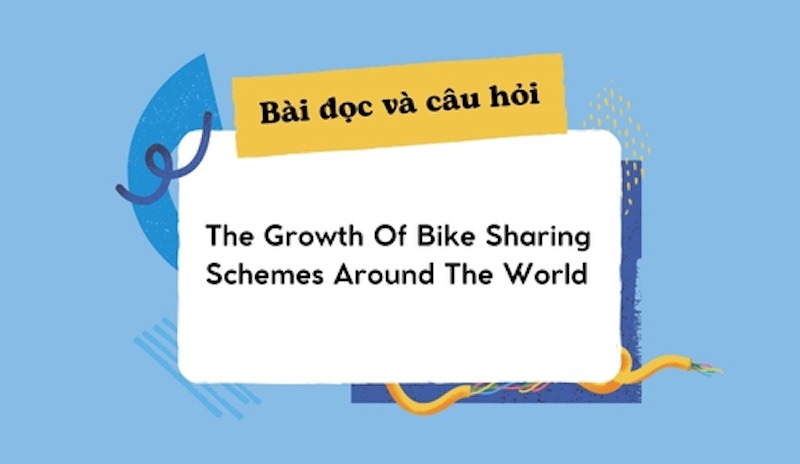The growth of bike sharing schemes around the world là một bài đọc thuộc cuốn sách Cambridge IELTS 14. Trong bài viết này, Edmicro sẽ cung cấp câu trả lời và hướng dẫn chi tiết cho các câu hỏi đọc hiểu.
The growth of bike sharing schemes around the world – Đề bài và câu hỏi
Cùng Edmicro đọc kỹ đề bài The growth of bike sharing schemes around the world để làm thật tốt bài tập này nhé!
The growth of bike sharing schemes around the world
How Dutch engineer Luud Schimmelpennink helped to devise urban bike-sharing schemes.
A – The original idea for an urban bike-sharing scheme dates back to a summer’s day in Amsterdam in 1965. Provo, the organisation that came up with the idea, was a group of Dutch activists who wanted to change society. They believed the scheme, which was known as the Witte Fietsenplan, was an answer to the perceived threats of air pollution and consumerism. In the centre of Amsterdam, they painted a small number of used bikes white. They also distributed leaflets describing the dangers of cars and inviting people to use the white bikes. The bikes were then left unlocked at various locations around the city, to be used by anyone in need of transport.
B – Luud Schimmelpennink, a Dutch industrial engineer who still lives and cycles in Amsterdam, was heavily involved in the original scheme. He recalls how the scheme succeeded in attracting a great deal of attention — particularly when it came to publicising Provo’s aims — but struggled to get off the ground. The police were opposed to Provo’s initiatives and almost as soon as the white bikes were distributed around the city, they removed them. However, for Schimmelpennink and for bike-sharing schemes in general, this was just the beginning. ‘The first Witte Fietsenplan was just a symbolic thing,’ he says. ‘We painted a few bikes white, that was all. Things got more serious when | became a member of the Amsterdam city council two years later.’
C – Schimmelpennink seized this opportunity to present a more elaborate Witte Fietsenplan to the city council. ‘My idea was that the municipality of Amsterdam would distribute 10,000 white bikes over the city, for everyone to use,’ he explains. ‘| made serious calculations. It turned out that a white bicycle — per person, per kilometre — would cost the municipality only 10% of what it contributed to public transport per person per kilometre.’ Nevertheless, the council unanimously rejected the plan. ‘They said that the bicycle belongs to the past. They saw a glorious future for the car,’ says Schimmelpennink. But he was not in the least discouraged.
D – Schimmelpennink never stopped believing in bike-sharing, and in the mid-90s, two Danes asked for his help to set up a system in Copenhagen. The result was the world’s first large-scale bike-share programme. It worked on a deposit: ‘You dropped a coin in the bike and when you returned it, you got your money back.’ After setting up the Danish system, Schimmelpennink decided to try his luck again in the Netherlands — and this time he succeeded in arousing the interest of the Dutch Ministry of Transport. ‘Times had changed,’ he recalls. ‘People had become more environmentally conscious, and the Danish experiment had proved that bike-sharing was a real possibility.’ A new Witte Fietsenplan was launched in 1999 in Amsterdam. However, riding a white bike was no longer free; it cost one guilder per trip and payment was made with a chip card developed by the Dutch bank Postbank. Schimmelpennink designed conspicuous, sturdy white bikes locked in special racks which could be opened with the chip card — the plan started with 250 bikes, distributed over five stations.
E – Theo Molenaar, who was a system designer for the project, worked alongside Schimmelpennink. ‘ I remember when we were testing the bike racks, he announced that he had already designed better ones. But of course, we had to go through with the ones we had.’ The system, however, was prone to vandalism and theft. ‘After every weekend there would always be a couple of bikes missing,’ Molenaar says.‘ I really have no idea what people did with them, because they could instantly be recognised as white bikes.’ But the biggest blow came when Postbank decided to abolish the chip card, because it wasn’t profitable. ‘That chip card was pivotal to the system,’ Molenaar says. ‘To continue the project we would have needed to set up another system, but the business partner had lost interest.’
F – Schimmelpennink was disappointed, but — characteristically — not for long. In 2002 he got a call from the French advertising corporation JC Decaux, who wanted to set up his bike-sharing scheme in Vienna. ‘That went really well. After Vienna, they set up a system in Lyon. Then in 2007, Paris followed. That was a decisive moment in the history of bike-sharing.’ The huge and unexpected success of the Parisian bike-sharing programme, which now boasts more than 20,000 bicycles, inspired cities all over the world to set up their own schemes, all modelled on Schimmelpennink. ‘It’s wonderful that this happened,’ he says. ‘But financially | didn’t really benefit from it, because | never filed for a patent.’
G – In Amsterdam today, 38% of all trips are made by bike and, along with Copenhagen, it is regarded as one of the two most cycle-friendly capitals in the world — but the city never got another Witte Fietsenplan. Molenaar believes this may be because everybody in Amsterdam already has a bike. Schimmelpennink, however, cannot see that this changes Amsterdam’s need for a bike-sharing scheme. ‘People who travel on the underground don’t carry their bikes around. But often they need additional transport to reach their final destination.’ Although he thinks it is strange that a city like Amsterdam does not have a successful bike-sharing scheme, he is optimistic about the future. ‘In the 60s we didn’t stand a chance because people were prepared to give their lives to keep cars in the city. But that mentality has totally changed.

Xem thêm: Changes In Reading Habits | Giải Đề CAM 16 Test 4 Reading Passage 2
Questions 1 – 5
The Reading Passage has seven paragraphs, A-G. Which paragraph contains the following information?
Write the correct letter, A-G, in boxes 1-5 on your answer sheet.
NB You may use any letter more than once.
- a description of how people misused a bike-sharing scheme
- an explanation of why a proposed bike-sharing scheme was turned down
- a reference to a person being unable to profit from their work
- an explanation of the potential savings a bike-sharing scheme would bring
- reference to the problems a bike-sharing scheme was intended to solve
Questions 6 and 7
Choose TWO letters, A-E.
Write the correct letters in boxes 6 and 7 on your answer sheet.
Which TWO of the following statements are made in the text about the Amsterdam bike-sharing scheme of 1999?
A. It was initially opposed by a government department.
B. It failed when a partner in the scheme withdrew support.
C. It aimed to be more successful than the Copenhagen scheme.
D. It was made possible by a change in people’s attitudes.
E. It attracted interest from a range of bike designers.
Questions 8 and 9
Choose TWO letters, A-E.
Write the correct letters in boxes 21 and 22 on your answer sheet.
Which TWO of the following statements are made in the text about Amsterdam today?
A. The majority of residents would like to prevent all cars from entering the city.
B. There is little likelihood of the city having another bike-sharing scheme.
C. More trips in the city are made by bike than by any other form of transport.
D. A bike-sharing scheme would benefit residents who use public transport.
E. The city has a reputation as a place that welcomes cyclists.
Questions 10 – 13
Complete the summary below. Choose ONE WORD ONLY from the passage for each answer.
Write your answers in boxes 10 – 13 on your answer sheet.
The first urban bike-sharing scheme
The first bike-sharing scheme was the idea of the Dutch group Provo. The people who belonged to this group were (10)…….…………. They were concerned about damage to the environment and about (11)…….……………, and believed that the bike-sharing scheme would draw attention to these issues. As well as painting some bikes white, they handed out (12)………….………. that condemned the use of cars.
However, the scheme was not a great success: almost as quickly as Provo left the bikes around the city, the (13)………..……….. took them away. According to Schimmelpennink, the scheme was intended to be symbolic. The idea was to get people thinking about the issues.
Đáp án đề bài The growth of bike sharing schemes around the world
Các bạn hãy so sánh bài làm của mình với đáp án đề The lost city the tomato của Edmicro nhé!
| Câu hỏi | Đáp án |
|---|---|
| 14 | E |
| 15 | C |
| 16 | F |
| 17 | C |
| 18 | A |
| 19 & 20 | B, D |
| 21 & 22 | C, D |
| 23 – 26 | activists |
| 24 | consumerism |
| 25 | leaflets |
| 26 | police |
Xem thêm: The Lost City – Đáp Án VÀ Hướng Dẫn Giải Chi Tiết
Hướng dẫn chi tiết bài đọc The growth of bike sharing schemes around the world
Dưới đây là những hướng dẫn giải chi tiết cho từng câu hỏi thuộc bài đọc này.
Câu 14 – câu 18
Câu 14: E – Đoạn E miêu tả chi tiết việc hệ thống xe đạp bị lạm dụng, khi nhiều chiếc xe bị mất và không rõ cách chúng bị sử dụng.
Câu 15: C – Đoạn C giải thích rằng kế hoạch của Schimmelpennink bị từ chối vì chính quyền tin rằng xe đạp đã lỗi thời và tương lai thuộc về ô tô.
Câu 16: F – Đoạn F đề cập rằng Schimmelpennink không thể hưởng lợi tài chính từ sáng tạo của mình vì ông không đăng ký bằng sáng chế.
Câu 17: C – Đoạn C cũng nêu rõ lợi ích kinh tế của kế hoạch xe đạp chia sẻ, với chi phí thấp hơn 10% so với giao thông công cộng.
Câu 18: A – Đoạn A nói về việc Provo đề xuất kế hoạch như một giải pháp cho ô nhiễm không khí và chủ nghĩa tiêu dùng.

Câu 19 và câu 20
- B: Đúng, Đoạn E mô tả rằng dự án thất bại vì Postbank, đối tác tài chính chính, rút lui khi hệ thống chip card không còn khả thi.
- D: Đúng, Đoạn D nhấn mạnh sự thay đổi trong thái độ xã hội và ý thức bảo vệ môi trường đã giúp kế hoạch mới thành công hơn.
Câu 21 và câu 22
- E: Đúng, Đoạn G nhắc đến việc Amsterdam được coi là một trong những thủ đô thân thiện với xe đạp nhất thế giới, cùng với Copenhagen. Điều này xác nhận rằng thành phố nổi tiếng với sự chào đón dành cho người đi xe đạp.
- D: Đúng, Schimmelpenninck lập luận rằng người sử dụng giao thông công cộng vẫn cần phương tiện bổ sung để di chuyển từ ga đến đích cuối.
Câu 23 – câu 26
Câu 23: activists – Đoạn A nói rằng Provo là một nhóm nhà hoạt động xã hội.
Câu 24: consumerism – Provo lo ngại về chủ nghĩa tiêu dùng và ô nhiễm môi trường.
Câu 25: leaflets – Provo phát tờ rơi để nâng cao nhận thức.
Câu 26: police – Đoạn B đề cập rằng cảnh sát đã thu hồi xe đạp ngay sau khi chúng được đặt ở thành phố.
Bài viết không chỉ cung cấp đáp án chính xác mà còn giải thích chi tiết, giúp người đọc nắm rõ cách trả lời các câu hỏi thuộc bài đọc the growth of bike sharing schemes around the world. Nếu cần thêm bất kỳ thông tin nào khác, hãy liên hệ ngay với Edmicro nhé!
Xem thêm:











